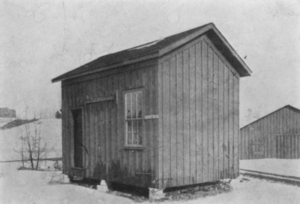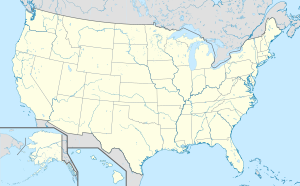Vulcan Street Plant
| Vulcan Street Plant | ||
|---|---|---|
| location | ||
|
|
||
| Coordinates | 44 ° 15 '29 " N , 88 ° 23' 49" W | |
| country |
|
|
| place | Appleton | |
| Waters | Fox River | |
| power plant | ||
| owner | Appleton Edison Light Co. | |
| Start of operation | September 30, 1882 | |
| technology | ||
| Bottleneck performance | 0.025 megawatts | |
| Average height of fall |
3 m | |
| Generators | 2 × direct current generator type K from Edison , 110 V. | |
| Others | ||
The Vulcan Street Plant is considered to be one of the oldest hydropower plants in the world, which delivered electricity to a distribution network and sold it to several customers. The plant was commissioned in 1882 and was the first hydropower plant, which Edison - generators began. They generated direct current with a voltage of 110 V with an output of 12.5 kW .
history
HJ Rogers, president of the paper mill and local gas company of Appletown , Wisconsin , was friends with SE Jacobs, a representative of the Western Edison Light Company . This company was founded in 1882 by well-known Chicago businessmen with the aim of selling electrical lighting systems in Chicago and building a power plant and distribution network in the city. Jacobs told Rogers about the steam-powered Pearl Street Station in New York City , which gave Rogers the idea of building a hydropower plant on the Fox River in Appletown . Rogers was able to inspire the owners of a steel mill and a banker with his idea and together with them he founded the Appleton Edison Light Co.
The company ordered two type K generators from Edison, the first of which was installed in the paper mill in the Holländer room, where it was powered by the Dutch drive. Because of the varying loads of the Dutch, the speed of the generator and thus the voltage fluctuated, so that the incandescent lamps did not emit uniform brightness, but instead shone brighter and darker. Sometimes the voltage rose so high that the light bulbs burned out.
The generator was therefore housed in a small extension to the administration building, where it was powered by its own water wheel. The second generator was originally located in the Vulcan paper mill across town, but the owners quickly decided to set up the two generators in their own woodshed between the two factories.
In December 1882, Appleton had three or more houses, five or six factories, and a smelter with electric lights. The local newspaper reported that Appleton had more electrically-lit houses than any other city in the US at the time.
The customers paid a flat rate per lamp and month. If the lamp was used all night, it was $ 1.20 per month, which was roughly $ 30 in 2019, adjusted for inflation. If the lamp was only used until 10 p.m., the flat rate was 84 cents . In the beginning, the operators of the power plant earned just under $ 300 per month.
In 1886 the power station was already too small. Two larger generators had to be bought, which were installed in a new central building, and the two existing generators were also brought to the new headquarters. In the same year, an electric tram started operating in Appleton, which ran until 1930.
technology
The Edison Type K generators were belt driven. Each generator sufficed to operate 250 light bulbs with six candle strengths each , which corresponded to an output of 12.5 kW . The terminal voltage was 110 volts . There were no gauges or displays in the facility, the operators controlled the facility by eye by observing the brightness of the light bulbs. The power plant was in operation from dusk to dawn, so all the light bulbs began to shine together as soon as the power plant was started.
The power lines were made with bare copper wires, so there were many short circuits at the beginning , especially when branches fell onto the lines in windy weather. The system then had to be shut down completely and the fault sought. It sometimes took an hour, but sometimes a day. During this time there was no electric light.
Historical classification
The Vulcan Street Plant was not the first to generate electricity using hydropower. In England, the system in Cragside went into operation as early as 1878 ; it was used to illuminate a country house and until 1880 only supplied a single carbon arc lamp .
See also
literature
- Louise P. Kellogg: The Electric Light System at Appleton . In: The Wisconsin Magazine of History . tape 6 , no. 2 , 1922, p. 189-194 , JSTOR : 4630421 .
Individual evidence
- ^ David B. Rushmore, Eric A. Lof: Hydro-electric power stations . New York, J. Wiley & sons, Inc .; etc., etc, 1923, p. 5 ( archive.org ).
- ↑ # 29 Vulcan Street Power Plant. In: ASME Engineering History Landmarks. Retrieved December 9, 2019 .
- ^ A b c d Milestones: Vulcan Street Plant, 1882. In: Engineering and Technology History Wiki. (English).
- ↑ a b c d e Louise P. Kellogg, p. 192, last section
- ^ Vulcan Street Plant . Brochure on the designation of the power plant as a National Historic Engineering Landmark. September 1977, p. 11 ( asme.org [PDF]).
- ^ Edward Fisher Bamber (Ed.): The scientific works of C. William Siemens: A collection of papers and discussions . tape III . London: J. Murray, 1889, p. 407 ( archive.org ).
- ^ Sarah Schmitz, Caroline Rawson: Rewiring 'A Temple to High Victorian Technology'. In: www.buildingconservation.com. Retrieved December 15, 2019 .

